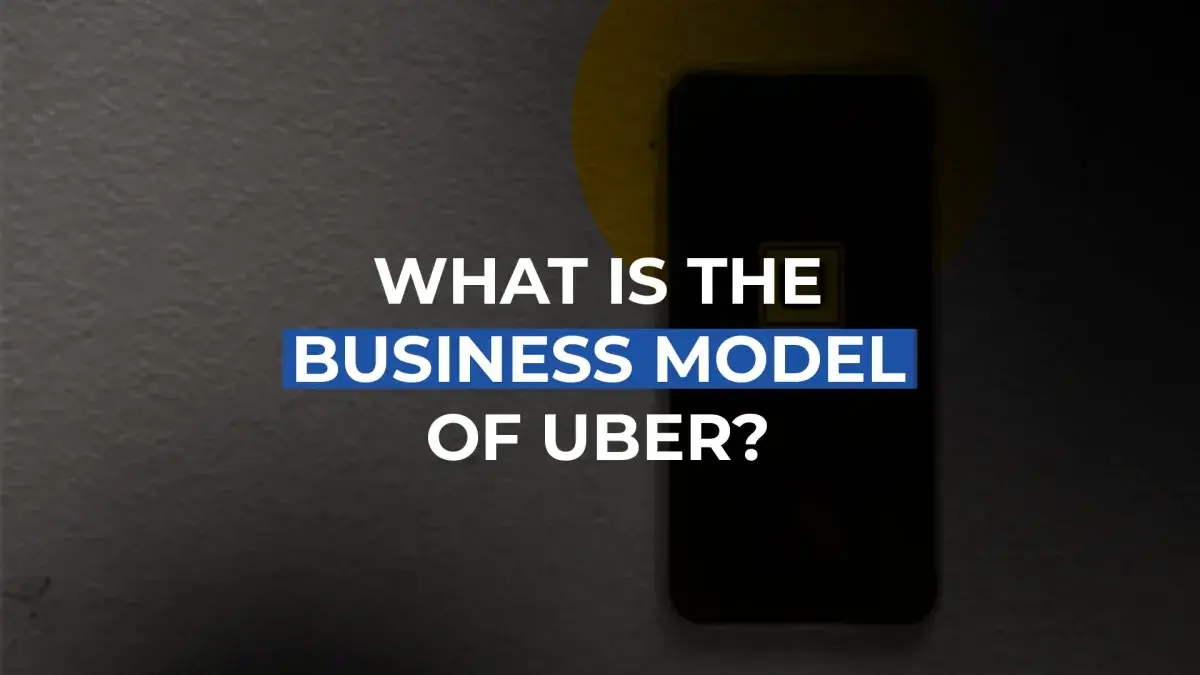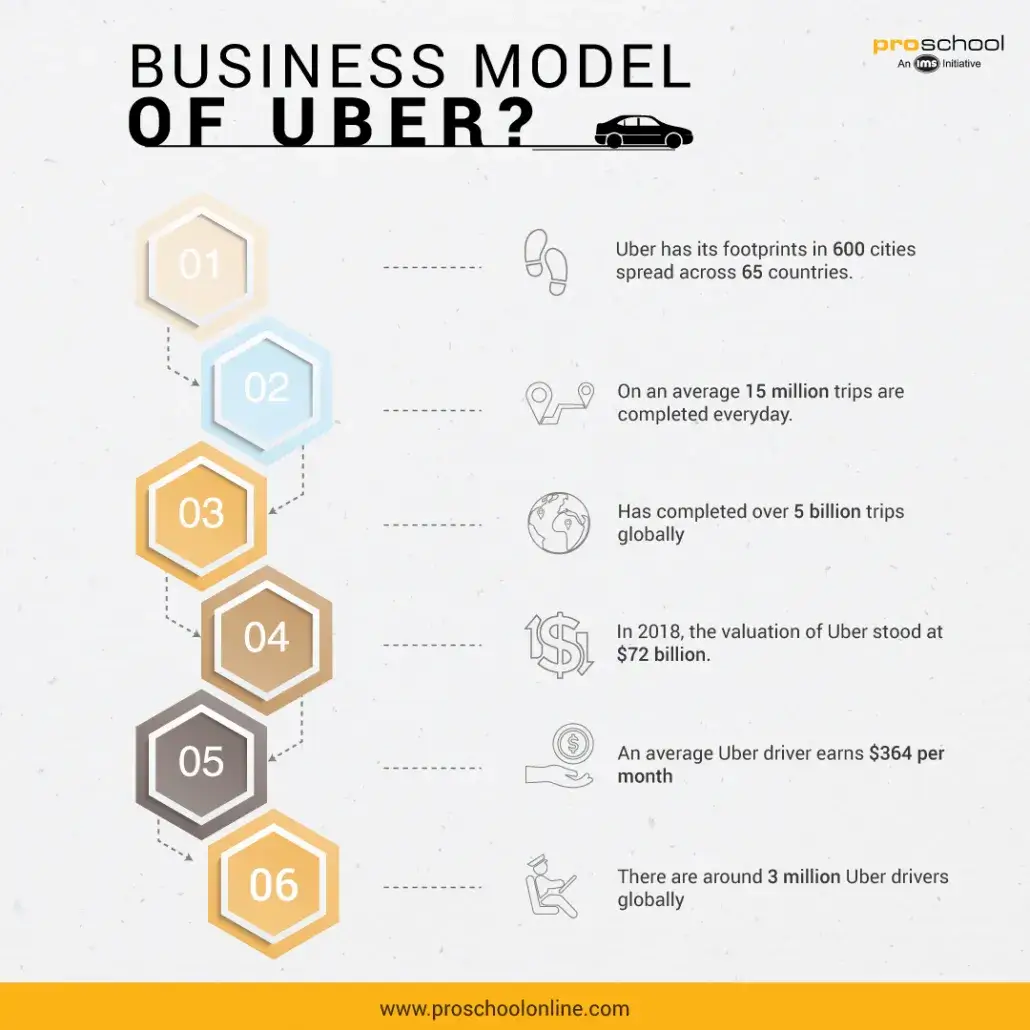What is the business model of Uber?

Here's What We've Covered!
Do you remember those long waiting hours in the middle of nowhere, where you are expecting for just at least one taxi to show up or you are required to walk 2kms to the main roads to get a cab? Well, Uber has been the solution to all such cab-related issues and so it is not just an app for us but a god-sent messiah. Nevertheless, the real description of Uber is that it is a smartphone app that provides on-demand service to its users. It has a very simple process where a registered Uber user makes a request over the app which then connects the willing passenger to a taxi driver. Founded in 2009, the Uber service is currently available in 600 cities across 65 countries. With more than 15 million daily trips, Uber has been able to clock a revenue of $11.3 billion in 2018. The USP of Uber is that it not like the traditional taxi business which believes in owning taxi and employing taxi drivers, rather it connects the passenger to a taxi driver and takes a share of the fare. So, if you are still wondering how exactly the business model works, then let me take you through this quick guide to help you understand the Uber business model better.
Components of Uber’s Business Model
Uber business model can be divided into three primary components:
- Passengers
- Taxi drivers
- Fare payment
Passengers: The model is initiated by the passengers who register themselves through the smartphone app and then book their on-demand services. Given that Uber is a customer-centric service, it is very important that the passengers feel at ease and as such immediately after the booking the app provides you the driver’s details and the estimated fares to be paid. In fact, the passengers are also able to track their rides while boarded.
Taxi drivers: The selection of the Uber taxi driver doesn’t involve any scientific algorithm. Anyone having a registered driving license and a car is eligible to become a Uber taxi driver. Based on seven-year background verification, the drives are shortlisted after which they are enlisted and provided with Uber phones for connecting to passengers. The taxi drivers are the important cog in the Uber business model and as such are identified as partners.
Fare payment: The estimated fare that is provided to the passenger at the time of booking is calculated based on the car type, distance and peak hours. You must have experienced that the fares face hike during the peak hours and lower down in the off hours, which is another excellent aspect of their revenue model. They offer you various payment modes keeping the ease of the users in mind, i.e. debit card, credit card, and online wallets.
How the business model works
The Uber business model works in four very simple steps as shown below:
Step 1: In this step, the passenger places the request for a cab through the Uber app by providing the pick-up and drop location.
Step 2: Once the request has been received by Uber, the user/passenger information is sent to the driver. Now, based on his / her availability and convenience, the taxi driver can either accept or reject the ride.
Step 3: Once a driver accepts the ride, the user is then notified about the acceptance along with the information regarding the taxi driver. The app allows the user to track the cab’s route and the ETA (Estimated Time of Arrival).
Step 4: Once the taxi arrives at the destination, the ride is marked over and then the user is required to do the payment. Further, the user gets an option to rate the trip, which is very important because it helps Uber to keep an account of the quality of service offered by each taxi driver.
The Revenue model
Uber’s revenue model has a uniqueness of its own as it is based on a variety of factors that not only includes the revenue through the customer’s trip commission, but also the surge pricing, revenue from cancellation of rides and endorsement of other products on the app. However, the principal revenue generation is contributed by 20 % of the fare charged to the customer, while the driver is entitled to the remaining 80%.
Now, let us look at two of the striking features of Uber that has helped the revenue growth of the period of time:
Diversified product offering: It is amazing to see how Uber has identified each customer segment and has built tailor-made offerings for them. The company has innumerable cab models assigned for each service category. For instance, Uber X and Uber SUV are for the elite class who can afford to pay a relatively higher fare for some additional luxury, while Uber Taxi is for those who want a cost-efficient solution.
Surge pricing: Uber uses a special pricing algorithm that automatically increases the price per mile based on the ongoing service demand. This variation in cab fares as per the surge pricing technique has been an important aspect of their business model as it supports the company revenue to some extent. Basically, the higher price depends on the number of requests made by willing passengers and the number of available drivers.
Learnings from Uber’s Business Model
Finally, let us jot down some of the important takeaways from Uber’s business model:
- Uber does not go for the ownership model, rather provides more than 15 million rides a day through its partner network
- Uber has identified the inherent problem in the cab industry and has successfully provided a solution and then introduced disruptive technological infrastructure
- Uber follows the principle that customers are the kings as they are the ones who will drive the business growth
- Uber acknowledges the role of their partner network and offers various incentive schemes for its taxi drivers as partners besides the 80% share of the total fare.
Interested in learning Financial Models across Industries?
Resent Post
>
Emerging commerce career options in India (2026): From CA to Data Analyst
>
ACCA Opportunities You Didn’t Know About – Think Beyond Audit!
>
Which Courses After 12th Commerce With High Salary Are in Demand Worldwide?
>
How to Find ACCA Jobs Online After Qualifying: Real Portals, Tips & Career Guidance
>
Financial Modelling Classes in Hyderabad: Your Guide to the Best Institutes
Follow Us For All Updates!



